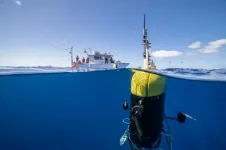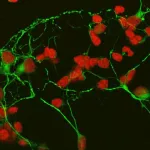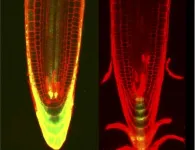(Press-News.org) An innovative underwater robot known as Mesobot is providing researchers with deeper insight into the vast mid-ocean region known as the "twilight zone." Capable of tracking and recording high-resolution images of slow-moving and fragile zooplankton, gelatinous animals, and particles, Mesobot greatly expands scientists' ability to observe creatures in their mesopelagic habitat with minimal disturbance. This advance in engineering will enable greater understanding of the role these creatures play in transporting carbon dioxide from the atmosphere to the deep sea, as well as how commercial exploitation of twilight zone fisheries might affect the marine ecosystem.
In a paper published June 16 in Science Robotics, Woods Hole Oceanographic Institution (WHOI) senior scientist Dana Yoerger presents Mesobot as a versatile vehicle for achieving a number of science objectives in the twilight zone.
"Mesobot was conceived to complement and fill important gaps not served by existing technologies and platforms," said Yoerger. "We expect that Mesobot will emerge as a vital tool for observing midwater organisms for extended periods, as well as rapidly identifying species observed from vessel biosonars. Because Mesobot can survey, track, and record compelling imagery, we hope to reveal previously unknown behaviors, species interactions, morphological structures, and the use of bioluminescence."
Co-authored by research scientists and engineers from WHOI, MBARI (Monterey Bay Aquarium Research Institute), and Stanford University, the paper outlines the robot's success in autonomously tracking two gelatinous marine creatures during a 2019 research cruise in Monterey Bay. High-definition video revealed a "dinner plate" jellyfish "ramming" a siphonophore, which narrowly escaped the jelly's venomous tentacles. Mesobot also recorded a 30-minute video of a giant larvacean, which appears to be nearly motionless but is actually riding internal waves that rise and fall 6 meters (20 feet). These observations represent the first time that a self-guided robot has tracked these small, clear creatures as they move through the water column like a "parcel of water," said Yoerger.
"Mesobot has the potential to change how we observe animals moving through space and time in a way that we've never been able to do before," said Kakani Katija, MBARI principal engineer. "As we continue to develop and improve on the vehicle, we hope to observe many other mysterious and captivating animals in the midwaters of the ocean, including the construction and disposal of carbon-rich giant larvacean 'snot palaces.'"
Packaged in an hydrodynamically efficient yellow case, the hybrid robot is outfitted with a suite of oceanographic and acoustic survey sensors. It may be piloted remotely through a fiberoptic cable attached to a ship or released from its tether to follow pre-programmed missions or autonomously track a target at depths up to 1,000 meters (3,300 feet). This autonomous capability will one day enable Mesobot to follow a target animal for over 24 hours without human intervention, which is enough time to observe its migration from the midwater twilight zone to the surface and back. Future studies with Mesobot could provide researchers with valuable insight into animal behavior during diel vertical migration, known as "the greatest migration on Earth" because of the vast number and diversity of creatures that undertake it each night.
"By leveraging the data we've collected using Mesobot, and other data that we've been curating for 30-plus years at MBARI, we hope to integrate smarter algorithms on the vehicle that uses artificial intelligence to discover, continuously track, and observe enigmatic animals and other objects in the deep sea," Kakani said.
INFORMATION:
The design, construction, and initial testing for Mesobot was funded by the U.S. NSF program for Ocean Technology and Interdisciplinary Coordination (OTIC). The research in this paper was supported by the David and Lucile Packard Foundation and WHOI's Ocean Twilight Zone (OTZ) Project, funded as part of The Audacious Project housed at TED.
See more Mesobot here:
https://youtu.be/5hjZtBvsmVY
About Woods Hole Oceanographic Institution
The Woods Hole Oceanographic Institution (WHOI) is a private, non-profit organization on Cape Cod, Massachusetts, dedicated to marine research, engineering, and higher education. Established in 1930, its primary mission is to understand the ocean and its interaction with the Earth as a whole, and to communicate an understanding of the ocean's role in the changing global environment. WHOI's pioneering discoveries stem from an ideal combination of science and engineering--one that has made it one of the most trusted and technically advanced leaders in basic and applied ocean research and exploration anywhere. WHOI is known for its multidisciplinary approach, superior ship operations, and unparalleled deep-sea robotics capabilities. We play a leading role in ocean observation and operate the most extensive suite of data-gathering platforms in the world. Top scientists, engineers, and students collaborate on more than 800 concurrent projects worldwide--both above and below the waves--pushing the boundaries of knowledge and possibility. For more information, please visit http://www.whoi.edu
About MBARI
MBARI (Monterey Bay Aquarium Research Institute) is a private non-profit oceanographic research center founded by David Packard in 1987. Shortly after he funded the creation of the Monterey Bay Aquarium, Packard recognized the need for a separate research institution focused on developing innovative technologies for exploring and understanding the ocean. MBARI partners with the Aquarium to educate the public and inspire ocean conservation and works to share the knowledge and solutions gained with the global science and conservation community.
Key takeaways:
Mesobot is an underwater robot capable of capturing high-resolution images and oceanographic data in the mid-ocean known as the "twilight zone," located approximately 200-1,000 meters (600-3,300 feet) below the surface.
Designed to minimize disturbance of fragile twilight zone creatures, Mesobot features red lights (which most mid-ocean creatures cannot see) and low-power thrusters that allow it to hover in place and track animals as they ride internal waves.
Mesobot is a hybrid vehicle, meaning it can be piloted remotely through a fiberoptic cable attached to a ship, or released from its tether to follow pre-programmed missions or autonomously track a target.
In tests, Mesobot successfully tracked two gelatinous animals without human intervention, recording valuable video of predation and filter-feeding behavior.
The data and imagery collected by Mesobot will allow scientists to study a relatively unknown part of the ocean and the creatures that live there, as well as how commercial exploitation of twilight zone fisheries might affect the marine ecosystem.
Mesobot will enable greater understanding of the "biological carbon pump," in which animals transport carbon dioxide from the atmosphere to the deep sea.
Media contacts:
Suzanne Pelisson
spelisson@WHOI.edu
Raúl Nava
raul@mbari.org
mediarelations@stanford.edu
CORVALLIS, Ore. - Human-caused wildfire ignitions in Central Oregon are expected to remain steady over the next four decades and lightning-caused ignitions are expected to decline, but the average size of a blaze from either cause is expected to rise, Oregon State University modeling suggests.
Scientists including Meg Krawchuk of the OSU College of Forestry and former OSU research associate Ana Barros, now of the Washington Department of Natural Resources, say the findings can help local decision-makers understand how a changing climate might affect natural and human-caused fire regimes differently and inform ...
Researchers at the National Eye Institute (NEI) have determined how certain short protein fragments, called peptides, can protect neuronal cells found in the light-sensing retina layer at the back of the eye. The peptides might someday be used to treat degenerative retinal diseases, such as age-related macular degeneration (AMD). The study published today in the Journal of Neurochemistry. NEI is part of the National Institutes of Health.
A team led by Patricia Becerra, Ph.D., chief of the NEI Section on Protein Structure and Function, had previously derived these peptides from a protein called pigment epithelium-derived ...
A study of young immigrant mothers who are survivors of sex trafficking found that the trauma affected how they parented: it made them overprotective parents in a world perceived to be unsafe, it fueled emotional withdrawal when struggling with stress and mental health symptoms, and was a barrier to building confidence as mothers. Yet, they coped with such challenges finding meaning in the birth of their child and through social support and faith.
Results of the community-based participatory research study by researchers at Columbia University ...
An alternate-day intermittent fasting schedule offered less fat-reducing benefits than a matched "traditional" diet that restricts daily energy intake, according to a new, 3-week randomized trial involving 36 participants. The study, which is one of the first to tease apart the effects of fasting and daily energy restriction in lean individuals, indicates that alternate-day fasting may offer no fasting-specific health or metabolic benefits over a standard daily diet. However, the authors caution that longer studies with larger groups are needed. Intermittent fasting, which involves cycling through voluntary fasting and non-fasting periods, has become one of the most popular approaches to losing weight. There ...
We've seen robots take to the air, dive beneath the waves and perform all sorts of maneuvers on land. Now, researchers at UC Santa Barbara and Georgia Institute of Technology are exploring a new frontier: the ground beneath our feet. Taking their cues from plants and animals that have evolved to navigate subterranean spaces, they've developed a fast, controllable soft robot that can burrow through sand. The technology not only enables new applications for fast, precise and minimally invasive movement underground, but also lays mechanical foundations for new types of robots.
"The biggest challenges with moving through the ground ...
In a study of more than 10,600 adult patients hospitalized with COVID-19, women had significantly lower odds than men of in-hospital mortality. They also had fewer admissions to the intensive care unit and less need for mechanical ventilation. Women also had significantly lower odds of major adverse events, including acute cardiac injury, acute kidney injury, and venous thromboembolism, according to an article in the peer-reviewed Journal of Women's Health. Click here to read the article now.
"This comprehensive analysis is the largest study to date that directly assesses the impact of sex on COVID-19 outcomes," ...
Boston - New study results indicate that different comorbid conditions affecting individuals diagnosed with COVID-19 may impact how long they continue to receive positive SARS-CoV-2 polymerase chain reaction (PCR) test results. Individuals diagnosed with COVID-19 who are aged 60+, have three or more chronic medical conditions, particularly diabetes, obesity, rheumatologic disease, or an organ transplant, have positive PCR tests for longer periods of time compared to younger individuals without these comorbidities. However, the data showed no significant difference in the duration of positive PCR tests results by the degree of immunocompromise or for individuals receiving chemotherapy or steroids ...
EAST LANSING, Mich. - The original Star Trek television series took place in a future when space is the final frontier, but humanity hasn't reached that point quite yet.
As researchers like Michigan State University entomologists Sarah Smith and Anthony Cognato are reminding us, there's still plenty to discover right here on Earth.
Working in Central and South America, the duo discovered more than three dozen species of ambrosia beetles -- beetles that eat ambrosia fungus -- previously unknown to science. Smith and Cognato described these new species on June 16 in the journal ZooKeys.
The Spartans also selected ...
Researchers from Skoltech and their colleagues from the UK have managed to create a stable giant vortex in interacting polariton condensates, addressing a known challenge in quantized fluid dynamics. The findings open possibilities in creating uniquely structured coherent light sources and exploring many-body physics under unique extreme conditions. The paper was published in the journal Nature Communications.
In fluid dynamics, a vortex is a region where a fluid revolves around a point (2D) or a line (3D); you've clearly seen one in your sink ...
Ikoma, Japan - Humans pride themselves on being able to multitask, especially under pressure. But it turns out that we aren't the only ones who are organized: researchers from Japan have discovered that plants balance genome maintenance with organ growth by organizing different responses to DNA damage.
In a study published in Science Advances, a research team led by Nara Institute of Science and Technology has revealed that plants use combined control of the plant hormones cytokinin and auxin to organize DNA damage responses while maintaining growth.
Plants are highly adaptable organisms that never stop growing, thanks largely to the functions carried out by their roots. Because of the essential role that roots play in plant growth, ...




